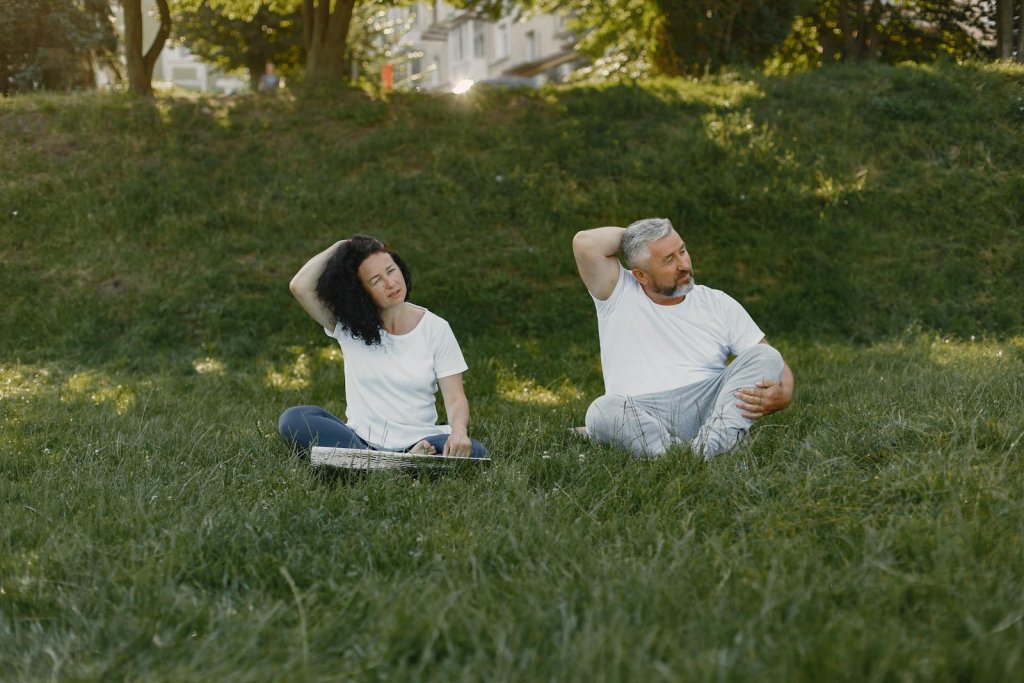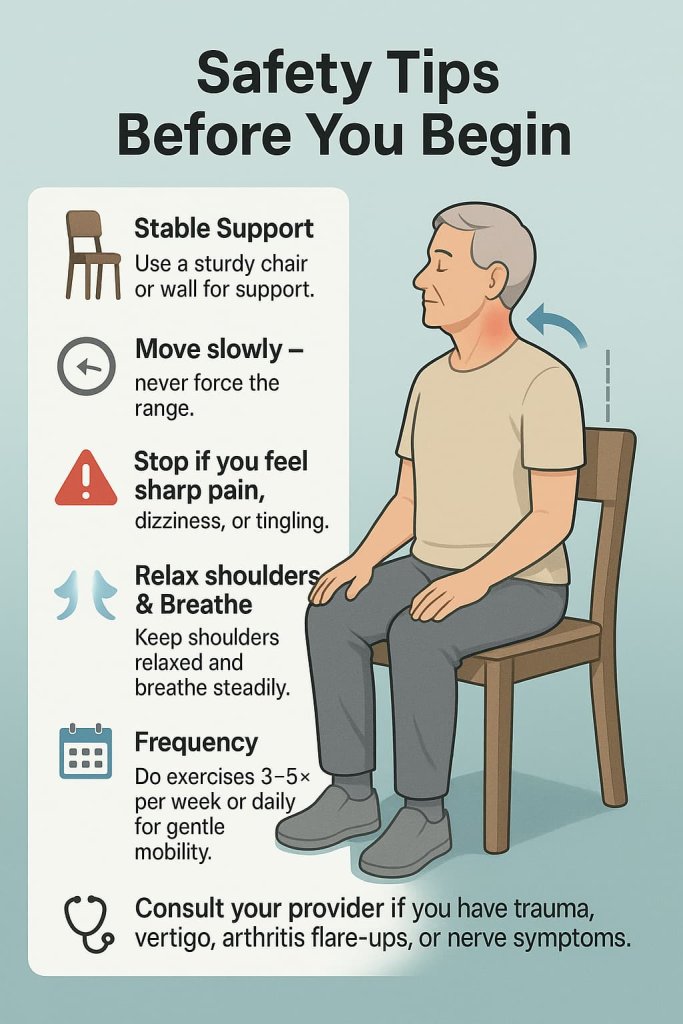Yes — seniors can safely improve neck mobility, posture, and comfort through gentle, consistent exercises.
The neck supports your head, which weighs around 10–12 pounds. Over time, aging, posture habits, and muscle stiffness can limit mobility and cause pain. Fortunately, evidence-based neck exercises help maintain flexibility, strengthen stabilizing muscles, and restore upright posture.

These exercises are designed specifically for seniors — easy to perform, low-impact, and safe when done correctly. You’ll learn eight simple moves to improve range of motion, release tension, and strengthen the muscles that support the neck and shoulders.
Why Neck Exercises Matter for Seniors
As we age, the neck and upper back gradually lose flexibility and muscle strength, often leading to stiffness, poor posture, and reduced comfort in daily life. Regular neck exercises help counter these changes by improving mobility, circulation, and muscle endurance — all essential for maintaining independence and ease of movement.

According to the National Institute on Aging (2024), gentle motion and strengthening routines protect joint function and prevent pain in older adults. Prolonged sitting, reading, or phone use can cause forward-head posture, increasing strain on the cervical spine and shoulder muscles.
Consistent neck exercise helps:
- Promote better posture and spinal alignment.
- Ease neck and shoulder tension from everyday activities.
- Support balance and coordination by improving head control.
- Enhance blood flow, reducing fatigue and stiffness.
A 2023 systematic review and meta-analysis in JOSPT found that exercise programs can reduce the risk of future neck pain episodes and improve symptoms, supporting simple, regular neck and upper-back exercises for older adults.
Safety Tips Before You Begin

- Sit in a sturdy chair or stand near a wall for balance.
- Move slowly and avoid forcing your range.
- Stop immediately if you feel sharp pain, dizziness, or tingling in your arms.
- Keep your shoulders relaxed and breathe evenly.
- Perform these exercises 3–5 times a week, or daily for gentle mobility.
Medical Note: If you have recent trauma, arthritis flare-ups, vertigo, or nerve symptoms, consult your healthcare provider before starting.
Warm-Up Before You Begin

Always start with 3–5 minutes of light movement to prepare your muscles and joints.
Quick Warm-Up Routine:
- Shoulder rolls – 10 forward and back
- Gentle head nods (“yes”) – 5 slow reps
- Side-to-side head rotations – 5 per side
- Scapular squeezes – 10 reps
Trainer Tip: Keep movements small and controlled. A warm neck moves better and is less prone to stiffness or strain.
8 Best Neck Exercises for Seniors
These eight senior-friendly exercises improve neck mobility, posture, and everyday comfort using gentle, low-impact movements. Each one supports safer turning, looking up or down, and maintaining balance throughout daily activities.
1. Chin Tuck (Seated or Standing)
Why it works:
Realigns the head over the shoulders, strengthens the deep neck flexors, and helps correct forward-head posture that develops with age. This exercise also reduces tension in the suboccipital muscles and supports better alignment for reading or computer use.
Muscles worked:
Deep cervical flexors (longus colli, longus capitis), suboccipitals, and upper trapezius (stabilizing role).
How to do it:
- Sit tall or stand upright with shoulders relaxed.
- Gently draw your chin backward (like creating a “double chin”) without looking down.
- Keep your eyes level and maintain a long spine.
- Hold for 5–10 seconds, then release.
- Repeat for 10 slow, controlled reps.
Trainer Tip:
Imagine sliding your head straight back toward an invisible wall — not tipping it down. Keep movement subtle and smooth.
2. Gentle Neck Rotation
Why it works:
Improves rotational range of motion and reduces stiffness caused by sedentary habits or looking in one direction for long periods. Encourages joint lubrication and balanced movement on both sides of the neck.
Muscles worked:
Sternocleidomastoid, splenius capitis and cervicis, levator scapulae, and upper trapezius.
How to do it:
- Sit tall, shoulders relaxed.
- Slowly turn your head to the right until you feel a gentle stretch (not pain).
- Hold 5 seconds, return to center.
- Repeat to the left side.
- Perform 8–10 reps each direction.
Trainer Tip:
Keep your chin parallel to the floor — avoid lifting or dipping as you turn.
3. Side Bending (Ear to Shoulder)
Why it works:
Improves flexibility of the side-neck muscles and alleviates tension from asymmetrical posture (e.g., favoring one side while sleeping or reading). Enhances mobility in the lateral plane for balanced cervical movement.
Muscles worked:
Upper trapezius, levator scapulae, and scalenes.
How to do it:
- Sit upright, feet grounded, shoulders relaxed.
- Slowly tilt your right ear toward your right shoulder without lifting the shoulder.
- Hold 5 seconds, return to center, then switch sides.
- Repeat 8 times per side.
Trainer Tip:
Breathe deeply throughout — exhale as you stretch. Avoid twisting or turning your head; keep your nose facing forward.
4. Isometric Neck Press (4 Directions)
Why it works:
Builds stability and strength safely without movement, protecting joints from excess strain. Excellent for seniors with arthritis, osteoporosis, or reduced neck mobility.
Muscles worked:
Cervical flexors, extensors, and lateral stabilizers.
How to do it:
- Sit tall with a neutral neck.
- Place your palm against your forehead.
- Gently press your head into your hand (forward) for 5 seconds — no visible movement.
- Relax, repeat 5 times.
- Move your palm to the back of your head (press backward), then to each side (press sideways).
- Perform 5 holds in each direction.
Trainer Tip:
Use light pressure — about 20–30% of your effort. The goal is gentle muscle engagement, not resistance training.
5. Scapular Retraction (Seated or Standing)
Why it works:
Strengthens upper-back muscles that support posture and neck alignment. By retracting the shoulder blades, this move counteracts rounded shoulders and forward-head posture.
Muscles worked:
Rhomboids, middle and lower trapezius, posterior deltoids.
How to do it:
- Sit or stand tall with arms at your sides.
- Gently squeeze your shoulder blades together and slightly downward.
- Hold 5 seconds, then relax.
- Repeat 10–12 times.
Trainer Tip:
Think “down and back,” not “up.” Avoid shrugging — your shoulders should stay relaxed and low.
6. Wall Angel (Posture Restorer)
Why it works:
Opens the chest and improves upper-back and shoulder mobility, which helps realign the cervical spine and reduce strain on the neck.
Muscles worked:
Mid-trapezius, rhomboids, erector spinae, and serratus anterior.
How to do it:
- Stand with your back, head, and hips against a wall.
- Bend elbows to 90°, arms out to sides (forming a “W”).
- Slowly slide your arms upward (toward a “Y”) while keeping elbows, wrists, and back in gentle contact with the wall.
- Lower arms back to the starting “W.”
- Repeat 8–10 times.
Trainer Tip:
Keep ribs and lower back lightly touching the wall — don’t arch. Move only within your comfortable range.
7. “Yes” Nod (Deep Neck Flexor Activation)
Why it works:
Activates small stabilizing muscles deep in the front of the neck that help maintain upright posture and reduce forward-head strain.
Muscles worked:
Longus capitis, longus colli, and deep neck flexors.
How to do it:
- Lie on your back with knees bent and head resting on the floor.
- Slowly nod your head as if saying “yes,” keeping the back of your head in light contact with the floor.
- Hold for 3 seconds, then relax.
- Repeat 10 times.
Trainer Tip:
Keep motion subtle — less than one inch of nodding. You should feel light muscle engagement under your chin, not pressure in your neck.
8. Upper Trapezius Stretch
Why it works:
Releases tightness in the upper shoulder and neck region, improving flexibility and reducing discomfort from chronic tension or stress.
Muscles worked:
Upper trapezius and levator scapulae.
How to do it:
- Sit tall, place your right hand behind your back.
- With your left hand, gently guide your head toward your left shoulder until you feel a light stretch on the right side of your neck.
- Hold 20–30 seconds, return to start.
- Repeat on the opposite side.
- Perform 2 rounds per side.
Trainer Tip:
Avoid pulling forcefully or twisting. Keep both shoulders relaxed and down throughout the stretch.
Programming Guide for Seniors
| Goal | Frequency | Sets/Reps | Notes |
|---|---|---|---|
| Mobility & Posture | 3–5 days/week | 1–2 sets of 8–10 reps | Perform slowly, with control |
| Pain Relief | Daily | 5–10 minutes | Focus on breathing and gentle motion |
| Strength Maintenance | 3× per week | Add light isometric resistance | Avoid fatigue or strain |
FAQs
1. Can I do these exercises every day?
Yes — gentle daily motion keeps joints lubricated and muscles active. Avoid overexertion or pain.
2. What if I have arthritis in my neck?
You can still perform these slowly and within pain-free limits. Focus on small movements and posture correction.
3. How long until I feel results?
You may notice reduced stiffness within 2–3 weeks of consistent practice.
4. Do I need special equipment?
No — just a chair and wall. A light band can be added for scapular work later.
5. Should I feel soreness afterward?
Mild muscle fatigue or light stretch is normal; sharp or radiating pain is not.
6. Are these safe if I have balance issues?
Yes, perform seated variations first and use wall support if needed.
7. When should I stop and seek medical advice?
If you feel dizziness, tingling, weakness, or severe pain, stop and contact a healthcare professional.
Conclusion
Improving neck mobility and posture doesn’t require intense workouts — just consistency and care. These eight exercises strengthen key neck and shoulder muscles, ease stiffness, and help you stay upright and comfortable.
Start today with just 5–10 minutes. Move gently, breathe deeply, and stay consistent — your neck (and posture) will thank you.
References
- National Institute on Aging (2024). Exercise & Physical Activity: Your Everyday Guide for Older Adults.
https://www.nia.nih.gov/health/exercise-physical-activity - Blanpied PR, et al. (2017). Neck Pain—Revision 2017: Clinical Practice Guidelines from JOSPT/APTA.
https://www.jospt.org/doi/10.2519/jospt.2017.0302 - Gross AR, et al. (2016). Exercises for Mechanical Neck Disorders—Cochrane Review (PubMed record).
https://pubmed.ncbi.nlm.nih.gov/26879546/
